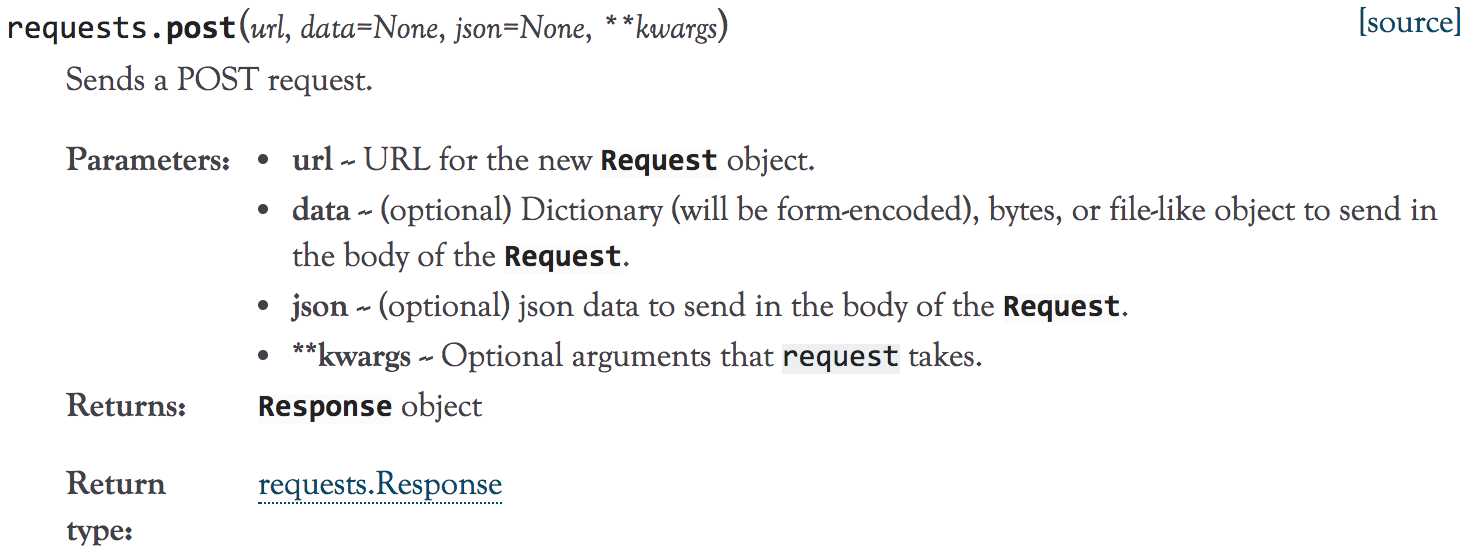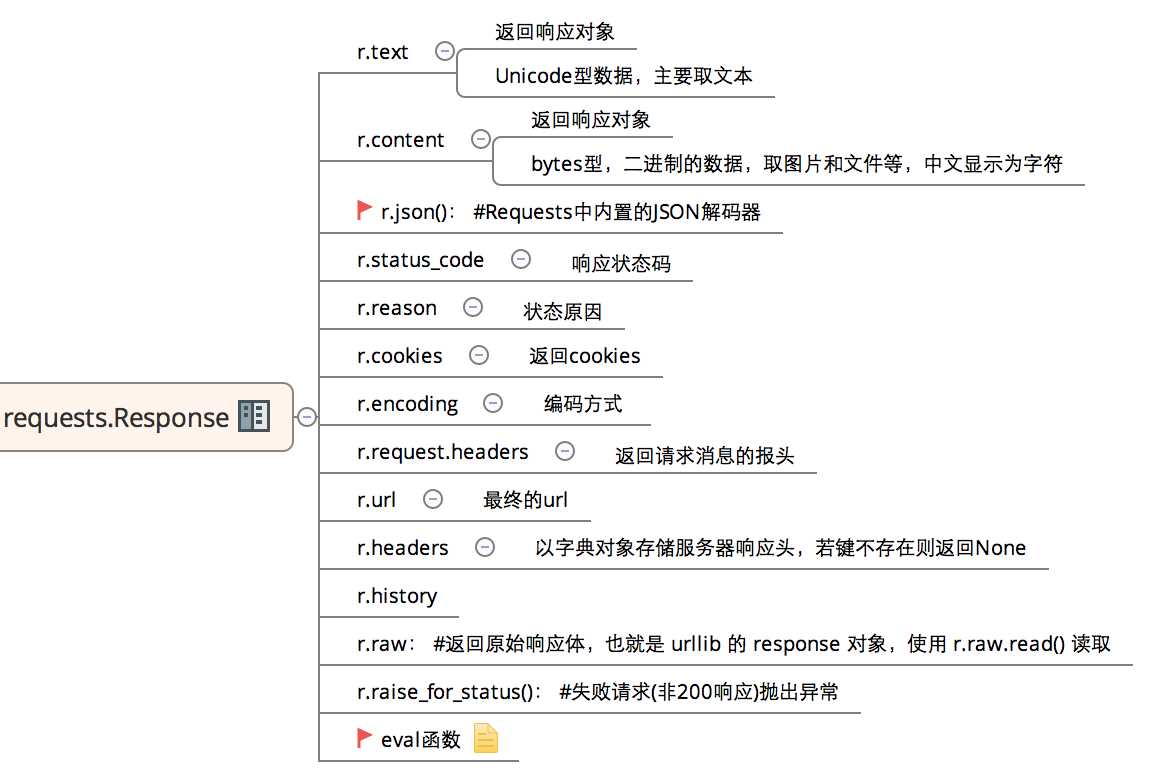接口自动化测试 request.post
Posted zhang-jun-jie
tags:
篇首语:本文由小常识网(cha138.com)小编为大家整理,主要介绍了接口自动化测试 request.post相关的知识,希望对你有一定的参考价值。
上一节介绍了 requests.get() 方法的基本使用,本节介绍 requests.post() 方法的使用:
本文目录:
一、方法定义
二、post方法简单使用
1、带数据的post
2、带header的post
3、带json的post
4、带参数的post
5、普通文件上传
6、定制化文件上传
7、多文件上传
一、方法定义:
1、到官方文档去了下requests.post()方法的定义,如下:

2、源码:

3、常用返回信息:

二、post方法简单使用:
1、带数据的post:
# -*- coding:utf-8 -*-
import requests
import json
host = "http://httpbin.org/"
endpoint = "post"
url = ‘‘.join([host,endpoint])
data = {‘key1‘:‘value1‘,‘key2‘:‘value2‘}
r = requests.post(url,data=data)
#response = r.json()
print (r.text)
输出:
{
"args": {},
"data": "",
"files": {},
"form": {
"key1": "value1",
"key2": "value2"
},
"headers": {
"Accept": "*/*",
"Accept-Encoding": "gzip, deflate",
"Connection": "close",
"Content-Length": "23",
"Content-Type": "application/x-www-form-urlencoded",
"Host": "httpbin.org",
"User-Agent": "python-requests/2.18.1"
},
"json": null,
"origin": "183.14.133.88",
"url": "http://httpbin.org/post"
}
2、带header的post:
# -*- coding:utf-8 -*- import requests import json
host = "http://httpbin.org/" endpoint = "post" url = ‘‘.join([host,endpoint]) headers = {"User-Agent":"test request headers"} # r = requests.post(url) r = requests.post(url,headers=headers) #response = r.json()
输出:
{
"args": {},
"data": "",
"files": {},
"form": {},
"headers": {
"Accept": "*/*",
"Accept-Encoding": "gzip, deflate",
"Connection": "close",
"Content-Length": "0",
"Host": "httpbin.org",
"User-Agent": "test request headers"
},
"json": null,
"origin": "183.14.133.88",
"url": "http://httpbin.org/post"
}
3、带json的post:
# -*- coding:utf-8 -*- import requests import json host = "http://httpbin.org/" endpoint = "post"
url = ‘‘.join([host,endpoint]) data = { "sites": [ { "name":"test" , "url":"www.test.com" }, { "name":"google" , "url":"www.google.com" }, { "name":"weibo" , "url":"www.weibo.com" } ] } r = requests.post(url,json=data) # r = requests.post(url,data=json.dumps(data)) response = r.json()
输出:
{
"args": {},
"data": "{"sites": [{"url": "www.test.com", "name": "test"}, {"url": "www.google.com", "name": "google"}, {"url": "www.weibo.com", "name": "weibo"}]}",
"files": {},
"form": {},
"headers": {
"Accept": "*/*",
"Accept-Encoding": "gzip, deflate",
"Connection": "close",
"Content-Length": "140",
"Content-Type": "application/json",
"Host": "httpbin.org",
"User-Agent": "python-requests/2.18.1"
},
"json": {
"sites": [
{
"name": "test",
"url": "www.test.com"
},
{
"name": "google",
"url": "www.google.com"
},
{
"name": "weibo",
"url": "www.weibo.com"
}
]
},
"origin": "183.14.133.88",
"url": "http://httpbin.org/post"
}
4、带参数的post:
# -*- coding:utf-8 -*-
import requests
import json
host = "http://httpbin.org/"
endpoint = "post"
url = ‘‘.join([host,endpoint])
params = {‘key1‘:‘params1‘,‘key2‘:‘params2‘}
# r = requests.post(url)
r = requests.post(url,params=params)
#response = r.json()
print (r.text)
输出:
{
"args": {
"key1": "params1",
"key2": "params2"
},
"data": "",
"files": {},
"form": {},
"headers": {
"Accept": "*/*",
"Accept-Encoding": "gzip, deflate",
"Connection": "close",
"Content-Length": "0",
"Host": "httpbin.org",
"User-Agent": "python-requests/2.18.1"
},
"json": null,
"origin": "183.14.133.88",
"url": "http://httpbin.org/post?key2=params2&key1=params1"
}
5、普通文件上传:
# -*- coding:utf-8 -*- import requests import json host = "http://httpbin.org/" endpoint = "post"
url = ‘‘.join([host,endpoint]) #普通上传 files = { ‘file‘:open(‘test.txt‘,‘rb‘) } r = requests.post(url,files=files) print (r.text)
输出:
{
"args": {},
"data": "",
"files": {
"file": "hello world!
"
},
"form": {},
"headers": {
"Accept": "*/*",
"Accept-Encoding": "gzip, deflate",
"Connection": "close",
"Content-Length": "157",
"Content-Type": "multipart/form-data; boundary=392865f79bf6431f8a53c9d56c62571e",
"Host": "httpbin.org",
"User-Agent": "python-requests/2.18.1"
},
"json": null,
"origin": "183.14.133.88",
"url": "http://httpbin.org/post"
}
6、定制化文件上传:
# -*- coding:utf-8 -*-
import requests
import json
host = "http://httpbin.org/"
endpoint = "post"
url = ‘‘.join([host,endpoint])
#自定义文件名,文件类型、请求头
files = {
‘file‘:(‘test.png‘,open(‘test.png‘,‘rb‘),‘image/png‘)
}
r = requests.post(url,files=files)
print (r.text)heman793
输出比较在,就不帖了。
7、多文件上传:
# -*- coding:utf-8 -*-
import requests
import json
host = "http://httpbin.org/"
endpoint = "post"
url = ‘‘.join([host,endpoint])
#多文件上传
files = [
(‘file1‘,(‘test.txt‘,open(‘test.txt‘, ‘rb‘))),
(‘file2‘, (‘test.png‘, open(‘test.png‘, ‘rb‘)))
]
r = requests.post(url,files=files)
print (r.text)
输出上,太多内容,不帖了。
8、流式上传:
# -*- coding:utf-8 -*-
import requests
import json
host = "http://httpbin.org/"
endpoint = "post"
url = ‘‘.join([host,endpoint])
#流式上传
with open( ‘test.txt‘ ) as f:
r = requests.post(url,data = f)
print (r.text)
输出:
{
"args": {},
"data": "hello world!
",
"files": {},
"form": {},
"headers": {
"Accept": "*/*",
"Accept-Encoding": "gzip, deflate",
"Connection": "close",
"Content-Length": "13",
"Host": "httpbin.org",
"User-Agent": "python-requests/2.18.1"
},
"json": null,
"origin": "183.14.133.88",
"url": "http://httpbin.org/post"
}
以上是关于接口自动化测试 request.post的主要内容,如果未能解决你的问题,请参考以下文章
